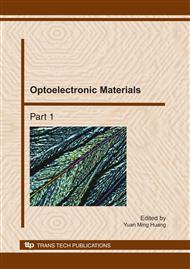p.158
p.162
p.166
p.170
p.177
p.183
p.187
p.191
p.195
Influence of Flux on Morphological and Luminescent Properties of Y3Al5O12:Tb3+ Phosphor
Abstract:
The Y3Al5O12: Tb3+ phosphors are synthesized by solid-state reaction method using fluxes of LiF, NaF, MgF2, AlF3, CaF2, SrF3, KH2PO4 and complex fluxes of LiF+AlF3, KH2PO4+LiF separately. The influence of fluxes on phosphors morphology and luminescent properties are investigated by SEM, HITACHI F-450 photometer and cathodoluminescent photometer. The results indicate that KH2PO4 can improve the morphology characteristics of the phosphors, but LiF, AlF3, NaF, MgF2, SrF3, CaF2 are unavailable. LiF, NaF, AlF3, KH2PO4 can improve the phosphors photoluminescent intensity more than 20 percent and cathodoluminescent intensity more than 10 percent. Using KH2PO4 as flux, excellent luminescent properties and well dispersed ~2 m spherical or sub-spherical YAG: Tb3+ phosphors can be synthesized under 1500 oC.
Info:
Periodical:
Pages:
177-182
Citation:
Online since:
November 2010
Authors:
Price:
Сopyright:
© 2011 Trans Tech Publications Ltd. All Rights Reserved
Share:
Citation:


